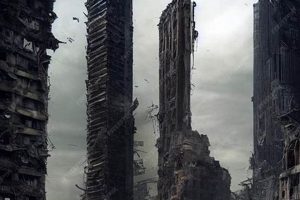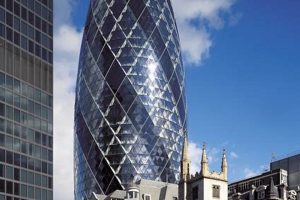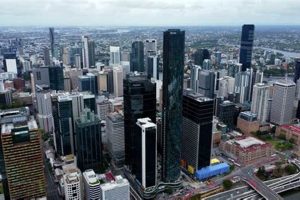Skyscrapers are exceptionally tall buildings that have become a defining feature of many urban skylines. They are designed to maximize the use of vertical space, allowing for efficient use of land and the creation of more living and working space in densely populated areas. Skyscrapers often house a variety of functions, including offices, residential units, retail stores, and public spaces.
The construction of skyscrapers requires advanced engineering techniques and materials. The earliest skyscrapers were built in the late 19th century, and since then, they have continued to evolve in terms of height, design, and sustainability. Today, skyscrapers are not only symbols of economic power and technological advancement but also contribute to urban life by providing mixed-use spaces, reducing commuting times, and fostering community development.
Skyscrapers have played a significant role in shaping the way we live and work in urban environments. They have facilitated the growth of cities, provided opportunities for businesses and individuals, and contributed to the overall vibrancy and diversity of urban life. As technology continues to advance, we can expect to see even more innovative and sustainable skyscrapers being built in the future, further transforming our urban landscapes.
1. Height
This remarkable height is not merely a defining characteristic of skyscrapers but also a testament to human ingenuity and the relentless pursuit of upward growth. It opens up new possibilities for space utilization, engineering challenges, and architectural expression, shaping the very fabric of urban environments.
- Vertical Density
Skyscrapers maximize vertical space, allowing for efficient use of land and the creation of more living and working space in densely populated areas. This density reduces urban sprawl, preserving green spaces and promoting sustainable urban development. - Engineering Marvels
The extraordinary height of skyscrapers demands innovative engineering solutions to ensure structural stability and withstand immense forces like wind and earthquakes. Advanced materials and construction techniques enable these towering structures to reach unprecedented heights while maintaining safety and resilience. - Architectural Statements
Skyscrapers are not just functional structures but also architectural masterpieces that shape the skyline and become iconic symbols of cities. Their height allows for unique design possibilities, creating visually striking landmarks that reflect cultural and technological advancements. - Symbolic Significance
The height of skyscrapers has often been associated with power, prestige, and economic prosperity. They serve as physical manifestations of a city’s ambition, innovation, and global standing, becoming symbols of urban progress and development.
In conclusion, the extraordinary verticality of skyscrapers is not just a matter of height but a combination of factors that have transformed urban landscapes, pushed the boundaries of engineering, and created architectural icons that embody the spirit of human endeavor.
2. Density
Skyscrapers play a crucial role in maximizing space utilization, creating vertical communities, and reducing urban sprawl. The density of skyscrapers allows for efficient use of land, enabling cities to accommodate more people and businesses within a limited geographical area. This vertical growth reduces the need for urban sprawl, preserving green spaces, natural habitats, and agricultural land on the outskirts of cities.
Vertical communities within skyscrapers foster a sense of community and shared living spaces. Mixed-use developments that combine residential, commercial, and public spaces create vibrant and walkable neighborhoods within these vertical structures. This proximity to amenities, workplaces, and entertainment options reduces the reliance on cars, promoting sustainable urban living.
Real-life examples of skyscraper-driven urban densification can be seen in cities like Hong Kong, Tokyo, and New York City. These metropolises have successfully implemented skyscraper development to accommodate their large populations while maintaining and natural spaces. By building upwards, these cities have preserved their horizontal landscapes, creating a balance between urban development and environmental sustainability.
Understanding the connection between skyscraper density and urban sprawl is crucial for sustainable urban planning. As cities continue to grow, the need for efficient land use and reduced environmental impact becomes increasingly important. Skyscrapers offer a viable solution by maximizing vertical space and creating compact, walkable communities that minimize urban sprawl.
3. Engineering
The remarkable heights and structural integrity of skyscrapers are testaments to the ingenuity and innovation in engineering. Advanced techniques and materials play a crucial role in ensuring these towering structures can withstand immense forces and heights.
- Structural Systems: Skyscrapers employ sophisticated structural systems, such as braced frames, shear walls, and outrigger systems, to distribute and resist lateral forces caused by wind and seismic activity. These systems work together to maintain the stability and integrity of the building.
- Materials Innovation: The use of advanced materials, such as high-strength steel, reinforced concrete, and composite materials, enables skyscrapers to achieve greater heights and heavier loads. These materials provide exceptional strength-to-weight ratios, allowing for slender and efficient designs.
- Wind Engineering: Wind engineering plays a critical role in designing skyscrapers to withstand wind forces. Wind tunnels are used to simulate wind patterns and analyze the aerodynamic behavior of the building. This knowledge informs the design of the building’s shape, cladding, and structural elements to minimize wind-induced vibrations and ensure stability.
- Seismic Engineering: In earthquake-prone regions, skyscrapers are engineered to withstand seismic forces. Base isolation systems, energy dissipation devices, and tuned mass dampers are employed to reduce the impact of earthquakes on the building’s structure and occupants.
The continuous advancements in engineering techniques and materials have pushed the boundaries of skyscraper design, allowing for taller, more sustainable, and architecturally striking structures. These engineering marvels not only shape our skylines but also serve as testaments to human ingenuity and the pursuit of vertical frontiers.
4. Su
stainability
The pursuit of sustainable practices has become an integral part of modern skyscraper design, with architects and engineers striving to reduce the environmental impact of these towering structures. Eco-friendly designs and technologies are employed to minimize energy consumption, water usage, and carbon emissions, contributing to a more sustainable urban environment.
- Energy Efficiency: Skyscrapers incorporate energy-efficient building systems, such as LED lighting, smart grids, and efficient HVAC systems, to reduce energy consumption. Facade design plays a crucial role, with double-glazed windows, solar shading, and daylighting strategies optimizing natural light and minimizing heat gain.
- Water Conservation: Water-saving fixtures, rainwater harvesting systems, and greywater recycling technologies are implemented to reduce water usage. Drought-tolerant landscaping and green roofs further contribute to water conservation efforts.
- Sustainable Materials: The use of sustainable materials, such as recycled steel, low-VOC paints, and FSC-certified wood, minimizes the environmental impact of construction and material sourcing. Prefabrication techniques also reduce construction waste and promote efficiency.
- Renewable Energy: Skyscrapers are increasingly incorporating renewable energy sources, such as solar panels, wind turbines, and geothermal systems, to generate clean energy and reduce reliance on fossil fuels.
The integration of sustainability into skyscraper design is not only a responsible approach to urban development but also a strategic move towards future-proofing these structures. As cities continue to grow and the demand for high-rise buildings increases, sustainable skyscrapers will play a crucial role in creating livable and environmentally conscious urban environments.
5. Mixed-use
In the realm of skyscrapers, mixed-use developments have emerged as a defining characteristic, seamlessly integrating residential, commercial, and public spaces within a single vertical structure. This approach to skyscraper design fosters diverse and vibrant communities, creating a microcosm of urban life within a single building.
The benefits of mixed-use skyscrapers extend beyond convenience and efficiency. They promote a sense of community, where residents, workers, and visitors interact in shared spaces, fostering a sense of belonging and social cohesion. This diversity of uses also creates a 24/7 vitality, with a constant flow of activity throughout the day and night, enhancing the overall urban experience.
Real-life examples of successful mixed-use skyscrapers can be found in cities worldwide. The Burj Khalifa in Dubai, the tallest building in the world, houses a mix of residential apartments, office spaces, a hotel, and a shopping mall. The Shanghai Tower in China combines offices, a hotel, retail outlets, and cultural venues, creating a thriving vertical community.
Understanding the connection between mixed-use developments and skyscrapers is crucial for architects, urban planners, and policymakers. By incorporating mixed-use elements into skyscraper design, cities can create more sustainable, livable, and dynamic urban environments. This approach promotes social interaction, reduces urban sprawl, and fosters a sense of community, ultimately enriching the urban fabric.
6. Economic Impact
Skyscrapers are not just architectural marvels but also potent symbols of economic power and prosperity. Their presence in a city’s skyline often signifies a strong and vibrant economy, attracting businesses, investments, and skilled professionals.
- Global Financial Hubs: Skyscrapers have become synonymous with global financial centers such as New York City, London, and Hong Kong. The concentration of banks, investment firms, and corporate headquarters in these towering structures reflects the economic clout of these cities.
- Corporate Prestige: Occupying a prime address in a prestigious skyscraper can enhance a company’s image and reputation. Many businesses view it as a strategic move to attract top talent and project a sense of success and stability.
- Investment Opportunities: Skyscrapers offer lucrative investment opportunities for real estate developers, investors, and pension funds. The potential for high returns on investment attracts capital from around the world, contributing to the overall economic growth of a city.
- Tourism and Hospitality: Iconic skyscrapers often become major tourist attractions, drawing visitors from far and wide. The observation decks, luxury hotels, and upscale retail spaces within these buildings generate significant revenue and support the hospitality industry.
In conclusion, the economic impact of skyscrapers extends beyond their physical presence. They serve as symbols of economic strength, attract businesses and investments, and contribute to the overall prosperity and vitality of cities. Their presence in a skyline is not just a reflection of architectural prowess but also an indication of a thriving and dynamic economy.
7. Cultural Significance
Skyscrapers transcend their functional purpose and become cultural icons, shaping the identity and image of cities. Their towering presence and unique architectural designs leave an indelible mark on the urban landscape, transforming them into symbols of a city’s aspirations, values, and achievements.
The Empire State Building in New York City, for example, is more than just an office building; it is an emblem of American ambition and resilience. The Petronas Towers in Kuala Lumpur, with their distinctive twin spires, have become synonymous with Malaysia’s economic and architectural prowess. And the Burj Khalifa in Dubai, the tallest building in the world, stands as a testament to human ingenuity and the city’s unwavering pursuit of grandeur.
The cultural significance of skyscrapers extends beyond their physical presence. They become backdrops for countless films, television shows, and literary works, further solidifying their iconic status. They inspire artists, architects, and designers, influencing various cultural expressions, from paintings to sculptures to fashion. In essence, skyscrapers become deeply embedded in a city’s cultural fabric, shaping its identity and serving as a source of pride for its inhabitants.
Understanding the cultural significance of skyscrapers is crucial for architects, urban planners, and policymakers. It underscores the importance of considering not just the functional and economic aspects of skyscraper development but also their potential impact on a city’s cultural heritage and identity. By embracing the cultural significance of skyscrapers, cities can foster a sense of place, attract tourism, and enhance the overall quality of life for their residents.
Skyscrapers
Skyscrap
ers, with their towering heights and architectural marvels, often spark curiosity and raise questions. Here are answers to some of the most frequently asked questions surrounding these iconic structures:
Question 1: What is the tallest skyscraper in the world?
As of 2023, the Burj Khalifa in Dubai, United Arab Emirates, holds the title of the tallest skyscraper in the world, standing at an impressive height of 828 meters (2,717 feet).
Question 2: How are skyscrapers able to withstand strong winds and earthquakes?
Skyscrapers employ advanced engineering techniques and materials to ensure their stability and resilience. Structural systems like braced frames and shear walls distribute and resist lateral forces caused by wind and seismic activity. High-strength steel, reinforced concrete, and composite materials provide exceptional strength-to-weight ratios, allowing for slender and sturdy designs.
Question 3: Are skyscrapers energy-efficient?
Modern skyscrapers incorporate sustainable designs to minimize their environmental impact. Energy-efficient building systems, such as LED lighting and smart grids, reduce energy consumption. Facade design plays a crucial role, with double-glazed windows and solar shading optimizing natural light and minimizing heat gain.
Question 4: How do skyscrapers contribute to urban development?
Skyscrapers play a significant role in urban development by maximizing space utilization and reducing urban sprawl. Mixed-use developments integrate residential, commercial, and public spaces within a single structure, fostering diverse and vibrant communities. They also serve as symbols of economic power and attract businesses and investments, contributing to the overall prosperity of cities.
Question 5: What are the cultural implications of skyscrapers?
Skyscrapers transcend their functional purpose and become cultural icons, shaping the identity and image of cities. Their unique architectural designs and towering presence leave an indelible mark on the urban landscape, inspiring artists, architects, and designers. They become backdrops for countless cultural expressions and serve as a source of pride for inhabitants.
Question 6: How are skyscrapers constructed?
Skyscraper construction involves advanced engineering techniques and specialized equipment. Deep foundations provide a stable base, while structural frameworks, often made of steel or reinforced concrete, support the building’s height. Curtain walls, typically made of glass and metal, form the building’s exterior, providing natural light and views while maintaining structural integrity.
Understanding these aspects of skyscrapers highlights their engineering prowess, sustainable features, urban impact, and cultural significance. As cities continue to grow and evolve, skyscrapers will undoubtedly remain a prominent part of our architectural landscape, pushing the boundaries of design, engineering, and urban living.
Transition to the next article section:
The world of skyscrapers is constantly evolving, with new technologies and architectural innovations emerging. From sustainable designs to smart building systems, the future of skyscrapers holds exciting possibilities for shaping our urban environments and skylines.
Skyscraper Design Tips
For architects and engineers, designing skyscrapers presents unique challenges and opportunities. Here are some tips to consider when embarking on such projects:
Tip 1: Prioritize Structural Integrity
Skyscrapers must withstand immense forces from wind, earthquakes, and gravity. Employ robust structural systems, such as braced frames, shear walls, and outrigger systems, to ensure stability and resilience.
Tip 2: Optimize Energy Efficiency
Implement sustainable design strategies to minimize energy consumption. Utilize energy-efficient building systems, natural lighting, and renewable energy sources to reduce the environmental footprint of the skyscraper.
Tip 3: Enhance Occupant Comfort
Create comfortable and healthy indoor environments for occupants. Consider factors like natural ventilation, daylighting, and thermal comfort to ensure a productive and enjoyable experience within the skyscraper.
Tip 4: Foster a Sense of Community
Incorporate mixed-use elements and public spaces to promote social interaction and community building. Design communal areas, such as rooftop gardens or sky lobbies, to encourage a sense of belonging among tenants and visitors.
Tip 5: Respect the Urban Context
Consider the surrounding urban environment when designing a skyscraper. Respect the architectural heritage, scale, and character of the area to ensure harmonious integration with the existing cityscape.
Tip 6: Embrace Technological Advancements
Leverage cutting-edge technologies to enhance the functionality, safety, and sustainability of the skyscraper. Explore smart building systems, advanced materials, and renewable energy solutions to create future-proof and innovative structures.
Tip 7: Seek Expert Collaboration
Collaborate with a team of experienced architects, engineers, and sustainability consultants to ensure a comprehensive and successful skyscraper design. Their expertise will guide you through the complexities of high-rise construction and ensure the project’s success.
Tip 8: Value Long-Term Sustainability
Design skyscrapers with longevity in mind. Choose durable materials, implement energy-efficient systems, and consider the building’s adaptability to future needs. By prioritizing long-term sustainability, you create a skyscraper that stands the test of time and minimizes its environmental impact.
By following these tips, architects and engineers can create skyscrapers that are not only structurally sound and visually striking but also sustainable, occupant-centric, and respectful of their urban surroundings.
Conclusion:
Skyscrapers, as symbols of architectural prowess and urban progress, require careful planning and innovative design approaches. By incorporating these tips into their design process, architects and engineers can create high-rise structures that are not only functional and aesthetically pleasing but also sustainable, resilient, and enhance the overall urban experience.
Conclusion
Skyscrapers, as we have explored, are monumental structures that have reshaped our skylines and continue to redefine the boundaries of architecture and engineering. Throughout this article, we have delved into the various aspects of skyscrapers, from their towering heights and structural marvels to their sustainability initiatives and cultural significance.
As we look towards the future, it is evident that skyscrapers will remain an integral part of our urban landscapes. By embracing sustainable practices, incorporating innovative technologies, and fostering a sense of community within these vertical cities, we can create skyscrapers that are not just architectural wonders but also symbols of human ingenuity and responsible urban development. The pursuit of skyscraping is a testament to our ambition, creativity, and the endless possibilities that lie ahead in the realm of architecture and urban design.







